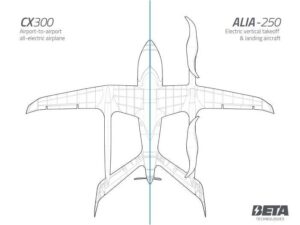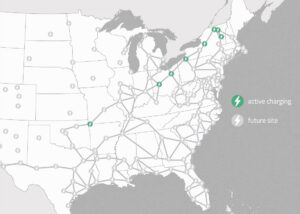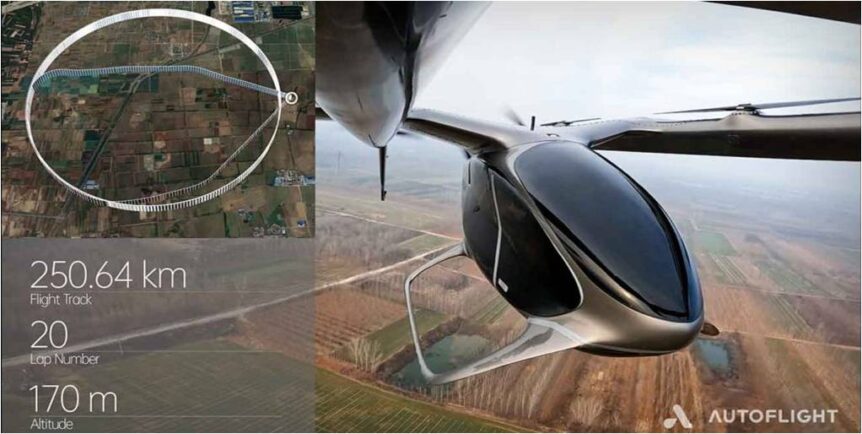Suddenly, we’re seeing new electric aircraft nudging, then doubling an electric distance record. First, Autoflight in China and then Beta in America achieve higher ranges than that previously achieved by Joby.
Jules Verne Saw It Coming
In two late 19th-century novels, Robur the Conqueror and Master of the World, Jules Verne chronicled the fictional adventurers of a mad inventor who thought he could dissuade world leaders from practicing war by bombing them from his Albatross flying warship. A great deal like Captain Nemo of Nautilus fame, Robur uses violence to stop violence. Both protagonists fail in their efforts.
The Albatross, mistaken as its objectives were, is perhaps an inspiration for today’s eVTOLs, propellers spinning for lift and for forward motion. Verne even prophesied fueling the Albatross with water, perhaps an early vision of today’s water-splitting to produce green hydrogen.
Autoflight
With far fewer rotors and propellers, Autoflight achieved a successful transition flight from vertical liftoff to forward flight. This delicate maneuver has now been achieved by craft from Opener’s Blackfly to Lillium’s Phoenix 2, varying degrees of complexity demonstrating that it can be done. Autoflight’s Prosperity 1 is among the latest to show this capability.
The four-passenger, 12.8-meter (42-foot) wingspan craft not only achieved a proper transition, but exceeded JOBY’s record distance by a narrow margin. Joby traveled for 154.6 miles in 2021, and Prosperity 1 nudged that with 155.74 miles in one hour and 38 minutes. Like Joby’s design, Prosperity 1 is a large machine, weighing around 3,300 pounds and carrying a payload of 900 pounds.
A four-passenger autonomous vehicle, Prosperity 1 is designed as an Urban Air Mobility carrier, lofting three passengers and a pilot initially, but eventually carrying four paying passengers on quick cross-city trips.
An outgrowth of Tian Yu’s original Yuneec drone program, Autoflight’s success was lauded by Yu, the firm’s CEO. “The team and I are thrilled to have cracked the smooth transition phase of eVTOL flight, unlocking the skies for Prosperity I and our commercial products. We are confident we have a good design underpinned by sound engineering, and delighted to see that the transition was smooth, safe and seamless.”
Mark Henning, formerly with Airbus and heading Autoflight’s European unit, concurs. “Achieving a smooth transition phase in record time, from prototype to flight, underlines the caliber of the engineering team we have at AutoFlight, and gives great confidence as we progress into the development phase and layout plans. The simplicity of AutoFlight’s design lies in our patented ‘Lift and Cruise’ configuration, which combines superior range and safety with low technical complexity, making it affordable to manufacture, maintain, and operate as an air taxi.”
Beta Technologies
Even while its Alia 250 flew from Plattsburgh, New York to Bentonville, Arkansas, Beta Technologies was quietly testing its CX-300, an electric Conventional Take Off and Landing (eCTOL) version of the plane. It’s flown over 22,000 miles in over two years of full-scale testing, providing an early chance for certification and a parallel path for the Alia. It’s “undergone qualitative evaluation flights by FAA, Air Force, and Army test pilots and has completed a 386-mile test flight, according to AviationToday.com
Both the Alia and CX-300 have substantial hours and miles over defined routes, and have shown their ability to operate with a growing infrastructure of charging stations, which Beta is establishing first along the eastern part of the country. The stations include crew quarters and operational necessities.
Because they are common designs, and the CX-300 eliminates the vertical lift rotors, almost all manufacturing can be duplicated. Pushed along by an improbably small diameter propeller, the CX-300 seems to have a good rate of climb in the video showing its flight from its home airport.

CX-300 (left) compared with Alia (right) showing common parts, much simpler CTOL configuration
Beta founder and CEO Kyle Clark explained the two airplanes “are common in their design, allowing us to economize validation of our high performance solutions. With the eCTOL aircraft launch we have further de-risked our path to commercialization and concurrently provide lower cost, more utility and optionality to operators. This has given us the confidence to industrialize and invest heavily in production at scale over the last year.”
Several organizations have placed orders for the eCTOL aircraft, including United Therapeutics, Bristow, Blade, and Air New Zealand. Since Beta expects certification and deliveries for the CX-300 by 2025, Air New Zealand could be flying “its first zero-emissions commercial demonstrator flight in 2026.”

Beta’s Route Map shows current (green) and future charging stations – eventually forming a nationwide network
Adding to the momentum, Beta has partnered with the government of the United Arab Emirates (the UAE) and United Parcel Service (UPS). The UAE granted a Minimum Viable License or MVL to operated Beta’s electric cargo aircraft in the country. This initially limits operations to CTOL machines. As with certification in other countries, the company can reuse the same data and materials for certification of the Alia.
The CX-300 should be easier to certify initially, because powered lift “makes pilot training requirements different from airplanes, adding more paperwork and time to ALIA’s approval. ”Regardless, worldwide demand seems to be strong enough for both products to be flying internationally before the end of the decade.
Summing Up
Both Autoflight and Beta Technologies are showing mission-appropriate distances with battery power. Beta’s CX-300 demonstrates that greater distances are possible when the vehicle does not have to lift all its weight vertically and hover during a transition. One wonders what might happen with either of these, or other similar machines, when hydrogen becomes more readily available.

